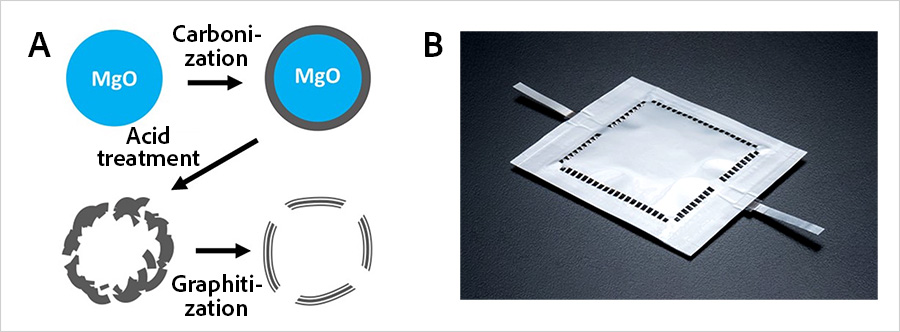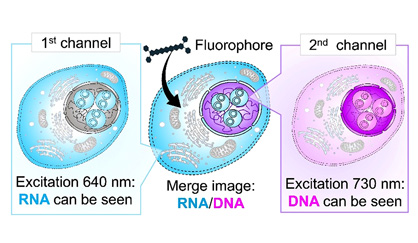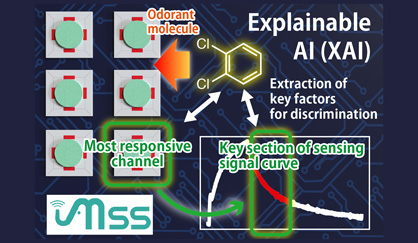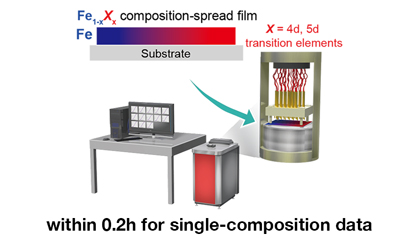Development of 1-Wh-Class Stacked Lithium-Air Cells
— New Carbon Electrode Simultaneously Enables Higher Output, Longer Life and Scalable Cell Design —2025.09.19
NIMS (National Institute for Materials Science)
Toyo Tanso Co., Ltd.
A joint research team from NIMS and Toyo Tanso has developed a carbon electrode that enables stable operation of a 1-Wh-class stacked lithium-air battery, achieving higher output, longer life and scalability simultaneously.
The team created this electrode by combining manufacturing technology that Toyo Tanso developed for its “CNovel™” porous carbon product with proprietary technology NIMS developed to fabricate self-standing carbon membranes.
This combination made it possible to scale up the battery cell size—a significant step toward practical, industrial-scale lithium-air batteries. The research was published online in Cell Reports Physical Science on September 18, 2025.
Abstract
Background
In 2021, a NIMS research group developed a lithium-air battery with a gravimetric energy density of approximately 500 Wh/kg—more than twice that of typical lithium-ion batteries.
However, several technical challenges remain before practical implementation is possible, including the need for higher output performance and longer cycle life.
Furthermore, most lithium-air batteries reported to date have had energy capacities of 0.01 Wh or less, making it essential to scale up cell size to advance research and development toward practical use.
Key Findings
In this study, proprietary technology developed by NIMS to fabricate self-standing carbon membranes was applied to Toyo Tanso’s CNovel™ porous carbon material, which features a controlled mesoporous structure.
This approach enabled the fabrication of carbon electrodes with a hierarchically controlled porous structure, resulting in high-output operation of lithium-air batteries.
In addition, by enhancing the crystallinity of the carbon electrode, the team improved its durability, thereby significantly extending the battery’s lifespan.
The researchers also established a manufacturing process capable of producing large-area electrodes measuring 10 cm × 10 cm or more, laying a solid technical foundation for scaling up to larger battery cells.
By integrating these advances, the team prototyped a 1-Wh-class stacked lithium-air battery using a 4 cm × 4 cm electrode and confirmed its stable operation.

Figure. (A) Schematic illustration of the synthesis process for a carbon material with controlled mesoscale porosity.
(B) External view of the 1-Wh-class stacked lithium-air battery fabricated in this study.
Future Outlook
Lithium-air batteries, known for their light weight and high energy capacity, are expected to play a vital role in advancing the electrification of critical sectors, such as electric aircraft and electric vehicles.
However, their practical use has long been constrained by technical challenges.
This study has made it possible to scale up the electrode area, paving the way for industrial-scale applications and representing a significant step toward the real-world deployment of lithium-air batteries.
Other Information
- This project was carried out by a joint research team led by Shoichi Matsuda (Leader, Automated Electrochemical Experiments Team (AEET), Research Center for Energy and Environmental Materials (GREEN), NIMS), Arghya Dutta (Special Researcher, AEET, GREEN, NIMS), Takashi Kameda (Engineer, AEET, GREEN, NIMS) and Takahiro Morishita (Executive Fellow, Kondo Teruhisa Memorial Advanced Carbon Technology Center, Toyo Tanso Co., Ltd.).
- This research was published online in Cell Reports Physical Science on September 18, 2025.
Published Paper
Authors : Arghya Dutta, Takashi Kameda, Emiko Mizuki, Taiga Ozawa, Shoji Yamaguchi, Junji Takada, Yuuka Nakajima, Takahiro Morishita, and Shoichi Matsuda
Journal : Cell Reports Physical Science
DOI : 10.1016/j.xcrp.2025.102841
Publication Date : September 18, 2025
Contact information
Regarding This Research
Leader, Automated Electrochemical Experiments Team
Research Center for Energy and Environmental Materials
National Institute for Materials Science
TEL: +81-29-860-4637
Executive Fellow
Kondo Teruhisa Memorial Advanced Carbon Technology Center
Toyo Tanso Co., Ltd.
Media Inquiries
Division of International Collaborations and Public Relations
National Institute for Materials Science
1-2-1 Sengen, Tsukuba, Ibaraki 305-0047, Japan
TEL: +81-29-859-2026
FAX: +81-29-859-2017
Corporate Planning Division
Toyo Tanso Co., Ltd.
Same Keywords
-
Chemical Crossover Accelerates Degradation of Lithium Electrode in High Energy Density Rechargeable Lithium–Oxygen Batteries
(lithium,batteries)
2023.01.31
-
Development of a Lithium-Air Battery with an Energy Density over 500 Wh/kg
(lithium)
2021.12.15
-
Cause of the Detrimental Charge Voltage Rise in Lithium-Air Batteries Identified
(lithium-air batteries,lithium)
2020.08.12



